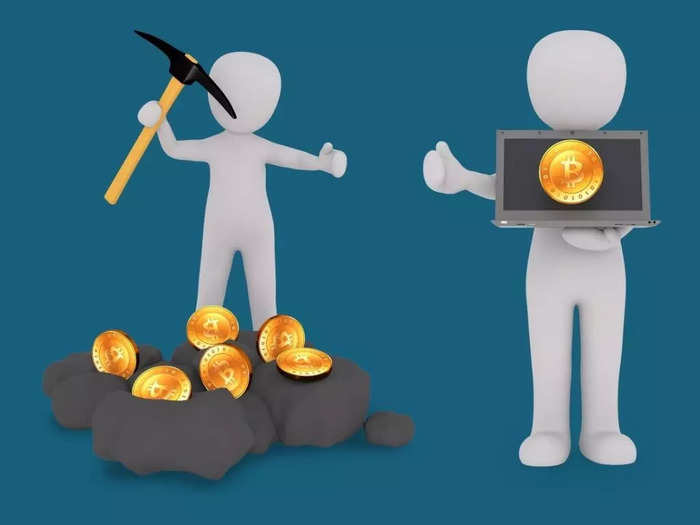- Home
- investment
- news
- Cryptocurrency isn’t for everyone — but here’s how some are using digital tokens to make money
Cryptocurrency isn’t for everyone — but here’s how some are using digital tokens to make money

- Crypto assets — whether that’s non-fungible tokens, Bitcoin, altcoins, or others — can yield significant returns for disciplined investors.
- The strategy chosen by an investor, like with traditional markets, depends on a person’s risk appetite.
- However, transaction costs and tax liabilities could nibble at the profits that one finally makes.
Seeing gains in crypto is not as easy as it used to be, but a disciplined approach continues to give good returns. The crypto market has transformed itself from the lawless Wild West to being closer to a market with unpredictable elements.
Beginners, looking to dip their toe in the cryptocurrency market, can make money in a number of ways.
Here are some of the easiest ways crypto holders make money — methods that normal retail investors can use, at a lower risk than complicated strategies that are less accessible.
Mining for coin

This is preferable for people who know their tech and want to see how cryptocurrency such as Bitcoin originates. Mining, while going right to the source, is not cheap. It could involve an upfront expense of ₹1 lakh on computing machinery, with no guarantee of quick rewards.
In addition to investing in either a PC or any kind of dedicated hardware, mining also consumes a massive amount of energy.
Miners can also earn ‘transaction fees’ for verifying trades made by others.
Traditional buy and hold

This method of making money from cryptocurrency is preferable for people with long investing horizons — who are willing to take a chance. This would involve buying a crypto asset of choice from a crypto exchange and buying more when possible or when prices drop — conventionally called ‘buying the dip’.
After months or years of HODLing — holding on for dear life — the asset may be sold at a significant overall profit compared to purchase cost.
Long established crypto coins — such as Bitcoin, Ethereum and Litecoin — do rise and fall in value daily, but have generally maintained an upward trend across years. Newer coins, such as Chia, are more likely to debut at a higher price due to hype, lose value and take a long time to recover, with the possibility of being snuffed out of existence if there aren’t enough buyers in the market or enough utility yielded by the function it serves.
Before choosing which cryptocurrency to hold onto as a long term investment, it is critical to read the coin’s whitepaper. It will explain its origins, the purpose it serves, and give enough information to ascertain whether it will stand the test of time.
Day trading with cryptocurrencies — coins and tokens

Not everyone has money they want to keep locked away as an investment in cryptocurrencies. Many would prefer to invest with a shorter time horizon. But this requires an appetite for risk. It would involve buying and selling fast, as well as being deeply involved with how and why the value of different cryptocurrencies change.
Experts only recommend this method for people who feel confident enough to time the coin markets, knowing the fundamentals well enough to consistently buy at a lower value and sell at a higher value. Some people may even buy the same coin at different price points, using dollar cost averaging, provided they’re confident of selling enough at a profit.
As expected, this approach would mean a lot of trades being done, so the per-transaction fees and tax (GST) would need to be considered. In addition to exchange fees for depositing and withdrawing investment in cryptocurrencies, sizable gains would be subject to income tax — so the actual profits in hand may be lower than what is visible at face value.
This method does not always yield the most profits, but it is usually the one where people lose the most on their bets.
Arbitrage between crypto assets

Arbitrage involves trading one cryptocurrency for another, or trading the same cryptocurrency on different exchanges. This method is preferred by people who are accustomed to day trading, and have an even higher appetite for risk than those who are simply day trading.
Being a hands-on trader reveals many imbalances in the market, and thus opportunities for profit each day.
For example, let’s assume XYZ coin is priced at ₹10 on one exchange and at ₹11 on the second. A person could then buy ten XYZ coins on the first exchange at ₹100, transfer the coin to the second exchange, and then sell the cryptocurrency for ₹110.
The absolute gain would seem to be ₹10. However, transaction costs could eat away as much as ₹8 and leave investors with a profit of only ₹2.
This is similar to how investors play fiat currencies against each other in traditional currency markets.
There could be more complex routes, such as transferring value between three currencies on the same exchange, to end up with a larger quantity of the first currency. This is usually done when the value of newer cryptocurrencies rises or falls considerably within minutes.
In other instances, ‘stablecoins’ whose value remains ‘tethered’ to specific national currencies – like Tether (USDT) which will remain at 1 USD – may be useful to benefit from imbalanced prices.
Staking — earning interest on crypto owned

Earning interest and fees is preferred by those who can afford to hold a large quantity of cryptocurrencies — called ‘locked up liquidity’ — even if its value changes. In return for taking the risk that they can’t sell their coin for a long time even if it becomes worthless, they are paid a very small ‘interest’.
One avenue of earning fees is by ‘staking’. This involves locking up a sizable ‘stake’ for a long term, to demonstrate investor confidence in a ‘proof of stake’ (PoS) based coin. The Ethereum coin, called Ether, is currently undergoing such a change, where investors — individually or collectively — can stake their holdings to validate transactions made by others, thus earning fees.
The other avenue of earning interest, comes from lending platforms and crypto exchanges. Investors can loan out coins and receive nominal interest of about 6% a year.
Experimental approaches

Other riskier tactics exist as well, some of which are inspired from practices not allowed in traditional markets.
Some crypto exchanges offer very high levels of leverage, upto a 100x multiplier. That enables a person who begins with ₹1, to trade as though they had ₹100, amplifying both gains and losses.
Some people may form cartels that coordinate online to manipulate a particular cryptocurrency’s price. This is normally done with new coins or those trading at low volumes, where a large quantity can be bought up by the cartels to ‘pump’ up the price. When the price is high enough to attract other investors that start buying, they sell — or ‘dump’ — before the price falls back down. This is called a ‘pump and dump’ scheme.
The infamous tactic has caught the fancy of influencers, who are now increasingly being called out for taking advantage of their fans and followers to ‘pump’ the price of cryptocurrencies before cashing out.
Directly earning in cryptocurrency

Those who won’t have the capital to invest in cryptocurrencies or buy expensive mining equipment have the option of earning cryptocurrency directly.
One way to do this is to sign up to a crypto exchange. Some crypto exchanges like Coinbase and BuyUcoin, offer a tiny quantity of free coin to users who sign up.
Some niche employers, with remote workers across borders, find it simpler to pay salaries in cryptocurrencies rather than fiat money due to forex fees.
Specialised social media sites — most famously Reddit — encourage participants to tip or donate coins to users who share important information. Non-franchise eateries are also starting to welcome payments in cryptocurrency.
Such miniscule earnings may not net large profits on trade, but they are an example of how cryptocurrencies are used as a medium of exchange for goods and services — akin to fiat currencies like the Rupee or Dollar.
Disclaimer

This is just a brief observation of the crypto market and is not financial advice. Do your own research (DYOR) before investing in any coin, token or crypto asset.
Popular Right Now
Advertisement